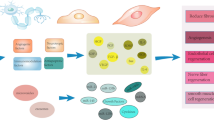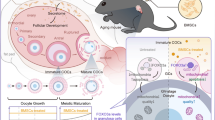Abstract
Spermatogonia stem cells (SSCs) are a unique cell population maintaining male spermatogenesis during life, through their potential for proliferation and differentiation. The application of silicon nanoparticles (SNs) and hyaluronic acid (HA) to induce the differentiation of SSCs seems promising. Herein, we investigate the effect of SN and HA scaffolds on the progression of SSCs spermatogenesis in mice. Initially SSCs were isolated from healthy immature mice and cultured on prepared scaffolds (HA, SN, and HA/SN) in a 3D culture system. Then viability of SSCs cultured on scaffolds was examined using MTT assay and Acridine Orange staining. Then SSCs cultured on scaffolds were transplanted into epididymal adipose tissue (EAT) in mature mice and the result was studied by H&E and IHC staining 8 weeks after transplantation. MTT and Acridine Orange analysis revealed that among three different scaffolds HA/SN based scaffold causes considerable toxicity on SSCs (P < 0.05) while H&E staining showed that culture of SSCs on HA, SN, and HA/SN scaffolds has a positive effect on the progression of SSCs spermatogenesis after transplantation into EAT. IHC staining identified TP1, TEKT1, and PLZF as crucial biomarkers in the spermatogenesis development of SSCs transplanted to EAT. According to the presence of these biomarkers in different experimental groups, we found the most spermatogenesis development in SSCs cultured on HA/SN scaffold (PLZF, P < 0.01) (TEKT1, P < 0.01) (TP1, P < 0.001). Our study showed that, although the cytotoxic effect of the HA/SN scaffold decreases the viability rate of SSCs; however, SSCs that survive on HA/SN scaffold showed more ability to progress in spermatogenesis after transplantation into EAT.








Similar content being viewed by others
Data availability
All data.
References
Abatangelo G, Vindigni V, Avruscio G, Pandis L, Brun P (2020) Hyaluronic acid: redefining its role. Cells 9(7):1743
Abdul Aziz MY, Omar AR, Subramani T, Yeap SK, Ho WY, Ismail NH, Alitheen NB (2014) Damnacanthal is a potent inducer of apoptosis with anticancer activity by stimulating p53 and p21 genes in MCF-7 breast cancer cells. Oncol Lett 7(5):1479–1484
Abeer MM, Rewatkar P, Qu Z, Talekar M, Kleitz F, Schmid R, Popat A (2020) Silica nanoparticles: a promising platform for enhanced oral delivery of macromolecules. J Controll Release 326:544–555
Alrahel A, Movahedin M, Mazaheri Z, Amidi F (2018) Study of Tnp1, Tekt1, and Plzf genes expression during an in vitro three-dimensional neonatal male mice testis culture. Iran Biomed J 22(4):258
Anjam RS, Movahedin M, Pourbeyranvand S, Moula SJ (2007) Assessment of morphological and functional changes in the mouse testis and epididymal sperms following busulfan treatment.
Chalkley H (1943) Method for the quantitative morphologic analysis of tissues. J Natl Cancer Inst 4(1):47–53
Costoya JA, Hobbs RM, Barna M, Cattoretti G, Manova K, Sukhwani M, Pandolfi PP (2004) Essential role of Plzf in maintenance of spermatogonial stem cells. Nat Genet 36(6):653–659
Geng X, Liu B, Liu J, Liu D, Lu Y, Sun X, Kong B (2018) Interfacial tissue engineering of heart regenerative medicine based on soft cell-porous scaffolds. J Thorac Disease 10(Suppl 20):S2333
Gisbert-Garzarán M, Lozano D, Vallet-Regí M (2020) Mesoporous silica nanoparticles for targeting subcellular organelles. Int J Mol Sci 21(24):9696
Guo C, Liu Y, Li Y (2021) Adverse effects of amorphous silica nanoparticles: focus on human cardiovascular health. J Hazard Mater 406:124626
Hosseinabadi M, Abdolmaleki Z, Beheshtiha SHS (2021) Cardiac aorta-derived extracellular matrix scaffold enhances critical mediators of angiogenesis in isoproterenol-induced myocardial infarction mice. J Mater Sci Mater Med 32(11):1–10
Huang R, Shen YW, Guan YY, Jiang YX, Wu Y, Rahman K, Zhang LJ, Liu HJ, Luan X (2020) Mesoporous silica nanoparticles: facile surface functionalization and versatile biomedical applications in oncology. Acta Biomater 116:1–15
Jahnukainen K, Stukenborg J-B (2012) Present and future prospects of male fertility preservation for children and adolescents. J Clin Endocrinol Metab 97(12):4341–4351
Koruji M, Movahedin M, Mowla SJ, Gourabi H, Pour-Beiranvand S, Arfaee AJ (2012) Autologous transplantation of adult mice spermatogonial stem cells into gamma irradiated testes. Cell J 14(2):82
Liu X-H, Xue S, Ma J-Z (2020) Mesoporous silica nanoparticles for bone tissue engineering. Zhongguo Gu Shang= China J Orthop Traumatol 33(8):784–787
Ma L, Song X, Yu Y, Chen Y (2021) Two-dimensional Silicene/silicon Nanosheets: an emerging silicon-composed nanostructure in biomedicine. Adv Mater 33(31):2008226
Majidi Gharenaz N, Movahedin M, Majidi S, Mazaheri Z (2020) A review on application of three dimensional culture and testicular scaffolds to induction of in-vitro spermatogenesis. SSU J 28(7):2794–2805
Medina-Reyes EI, Rodríguez-Ibarra C, Déciga-Alcaraz A, Díaz-Urbina D, Chirino YI, Pedraza-Chaverri J (2020) Food additives containing nanoparticles induce gastrotoxicity, hepatotoxicity and alterations in animal behavior: The unknown role of oxidative stress. Food Chem Toxicol 146:111814
Mohand-Kaci F, Assoul N, Martelly I, Allaire E, Zidi M (2013) Optimized hyaluronic acid–hydrogel design and culture conditions for preservation of mesenchymal stem cell properties. Tissue Eng Part C Methods 19(4):288–298
Mohaqiq M, Movahedin M, Mazaheri Z, Amirjannati N (2019) In vitro transplantation of spermatogonial stem cells isolated from human frozen–thawed testis tissue can induce spermatogenesis under 3-dimensional tissue culture conditions. Biol Res 52(1):1–9
Molgaard-Hansen L, Glosli H, Jahnukainen K, Jarfelt M, Jónmundsson GK, Malmros-Svennilson J (2011) Quality of health in survivors of childhood acute myeloid leukemia treated with chemotherapy only: a NOPHO-AML study. Pediatric Blood Cancer 57(7):1222–1229
Nishimura H, L’Hernault SW (2017) Spermatogenesis. Curr Biol 27(18):R988–R994
Park J-Y, DiPalma DT, Kwon J, Fink J, Park J-H (2019) Quantitative difference in PLZF protein expression determines iNKT lineage fate and controls innate CD8 T cell generation. Cell Rep 27(9):2548-2557. e2544
Pereira H, Sousa DA, Cunha A, Andrade R, Espregueira-Mendes J, Oliveira JM, Reis RL (2018) Hyaluronic acid. Osteochondral Tissue Eng 137–153
Reda A, Hou M, Landreh L, Kjartansdóttir KR, Svechnikov K, Söder O, Stukenborg J-B (2014) In vitro spermatogenesis–optimal culture conditions for testicular cell survival, germ cell differentiation, and steroidogenesis in rats. Front Endocrinol 5:21
Sharma N, Jha S (2020) Amorphous nanosilica induced toxicity, inflammation and innate immune responses: a critical review. Toxicology 441:152519
Skakkebaek NE (2017). Sperm counts, testicular cancers, and the environment: British Medical Journal Publishing Group.
Xu Y, Wang N, Yu Y, Li Y, Li Y-B, Yu Y-B, Sun Z-W (2014) Exposure to silica nanoparticles causes reversible damage of the spermatogenic process in mice. PLoS ONE 9(7):e101572
Yang Y, Lin Q, Zhou C, Li Q, Li Z, Cao Z, Zhang Q (2020) A testis-derived hydrogel as an efficient feeder-free culture platform to promote mouse spermatogonial stem cell proliferation and differentiation. Front Cell Dev Biol 8:250
Zhao M, Shirley CR, Mounsey S, Meistrich ML (2004) Nucleoprotein transitions during spermiogenesis in mice with transition nuclear protein Tnp1 and Tnp2 mutations. Biol Reprod 71(3):1016–1025
Funding
There is no financial funding.
Author information
Authors and Affiliations
Corresponding author
Ethics declarations
Conflict of interest
All authors declared that they have no conflict of interest.
Patient consent
Not applicable.
Additional information
Publisher's Note
Springer Nature remains neutral with regard to jurisdictional claims in published maps and institutional affiliations.
Rights and permissions
Springer Nature or its licensor (e.g. a society or other partner) holds exclusive rights to this article under a publishing agreement with the author(s) or other rightsholder(s); author self-archiving of the accepted manuscript version of this article is solely governed by the terms of such publishing agreement and applicable law.
About this article
Cite this article
Saharkhiz, S., Abdolmaleki, Z. & Eslampour, M.A. Hyaluronic acid/silicon nanoparticle scaffold induces proliferation and differentiation of mouse spermatogonial stem cells transplanted to epididymal adipose tissue. Cell Tissue Bank 25, 231–243 (2024). https://doi.org/10.1007/s10561-023-10093-1
Received:
Accepted:
Published:
Issue Date:
DOI: https://doi.org/10.1007/s10561-023-10093-1




